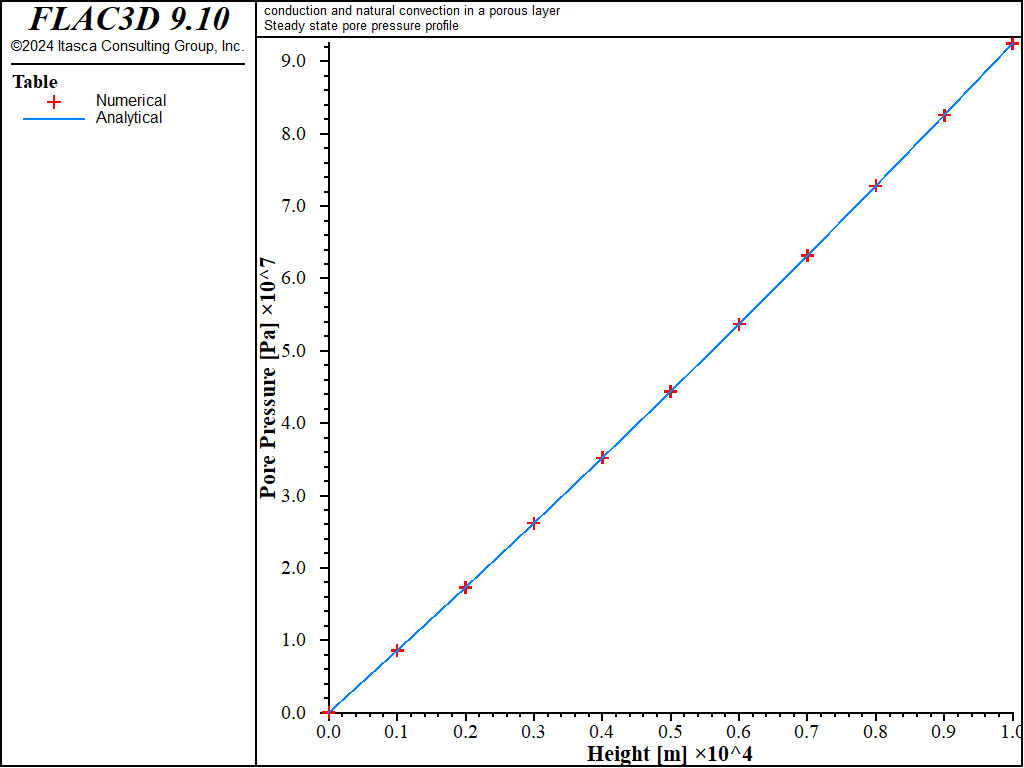Steady-State Convection in a Saturated Porous Medium Heated from Above
Note
To view this project in FLAC3D, use the menu command . The project’s main data files are shown at the end of this example.
This example shows the effect of temperature-dependent density on the pore-pressure distribution for heating applied from above a saturated porous layer of large lateral extent. The thickness of the layer is \(b\). The temperature is fixed at \(T_1\) at the base of the layer and at \(T_0 > T_1\) at the top. The boundaries are impermeable to fluid flow; the problem is one-dimensional. For zero specific discharge, the steady-state temperature solution is
where \(x\) is measured down, from the top of the layer. Assuming no fluid flow, we have
Using \(\rho = \rho_0[1 - \beta (T - T_r)]\), where \(T_r\) is a reference temperature and \(T\) is given by the temperature solution (Equation (1)), integration of this equation gives
where \(p_0\) is a reference pressure.
To simulate the problem with FLAC3D, we first establish the temperature field and cycle in flow mode until the steady-state pore pressure solution is reached. For the case treated, the relative pore-pressure error calculated at the end of the simulation is negligible (less than 10-5%; see Figure 1).

Figure 1: Comparison of numerical (symbols) and analytical (solid lines) pore pressure profiles at steady state for a porous saturated layer heated from above.
Data File
model new
model title 'conduction and natural convection in a porous layer'
program call 'parameters' suppress
; --- geometry ---
zone create brick size 5 5 10 point 0 (-5e3,-5e3,-5e3) ...
point 1 (5e3,-5e3,-5e3) ...
point 2 (-5e3,5e3,-5e3) ...
point 3 (-5e3,-5e3,5e3)
; (mechanical)
zone property density 2000
; (thermal)
model configure thermal
zone thermal cmodel advection-conduction
zone thermal property conductivity=[condu] specific-heat=[mspec]
zone thermal property conductivity-fluid=[fcond] specific-heat-fluid=[fspec]
zone thermal property expansion-fluid=[fthex] expansion=[thexp]
zone thermal property temperature-reference=[T1]
; (fluid)
model configure fluid-flow
zone fluid property porosity=[poros] mobility-coefficient=[mobil]
zone fluid property undrained-thermal-coefficient=0
zone fluid property fluid-modulus=2e5
zone fluid property fluid-density=[fdens]
; --- boundary conditions ---
zone face apply temperature [T1] range position-z -5e3
zone face apply temperature [T0] range position-z 5e3
; --- settings ---
model gravity 10
; --- conduction solution ---
zone fluid property fluid-density=0.0
model solve-thermal time-total 8e13
zone fluid property fluid-density=[fdens]
model solve-fluid time-total 8e12
model save 'naturalAdvection'
⇐ One-Dimensional Solution of Thermal Transport by Forced Convection and Conduction | Steady-State Convection in a Saturated Porous Medium Heated from Below ⇒
| Was this helpful? ... | Itasca Software © 2024, Itasca | Updated: Aug 13, 2024 |
